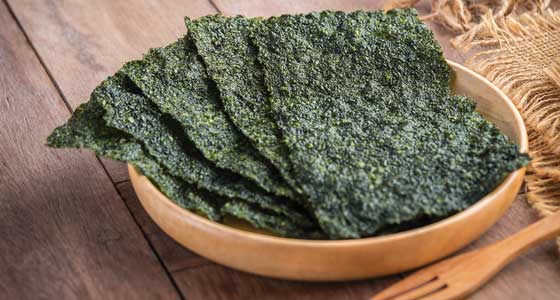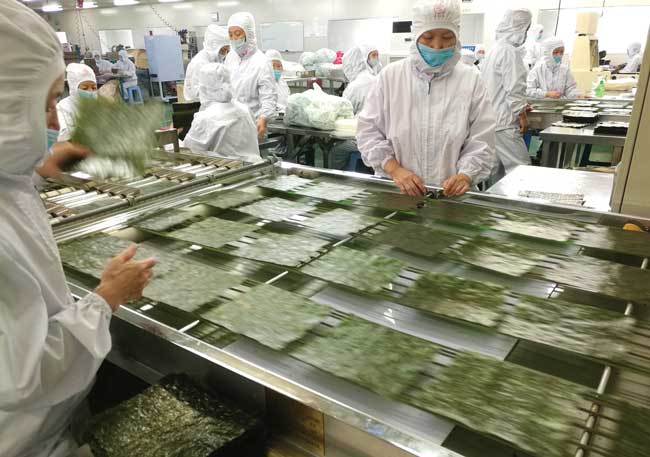Seeing Opportunities in Seaweed
PROCESSING

This month’s column will continue the theme of “How is it processed?” with a look at edible seaweed. While not all algae are edible, some seaweeds—or sea vegetables—have become an increasingly popular food ingredient around the world. This column explores traditions of consuming seaweed and how one type of seaweed, nori, is cultivated and processed. I wish to thank my co-author, Amanda Sinrod, food specialist at the University of California, Davis, and the U.S. Department of Agriculture’s Agricultural Research Service, for contributing to this column.
Nutrition, History, and Market
Marketed as a “superfood,” seaweed is an excellent source of dietary fiber, vitamins A, D, C, E, and B and minerals including calcium, sodium, potassium, iodine, and phosphorus. This low-calorie vegetable also has hypotensive properties, reducing the risk of cardiovascular disease. However, despite these health benefits, seaweed has been largely absent from Western diets until recently. Much of seaweed’s limited presence has been due to its unique gelling characteristics with the production and use of carrageenan, agar, and alginate in foods. Seaweed hydrocolloids are used for gelation and thickening in food products. These compounds are commercially extracted from red and brown seaweeds using enzyme treatments, and as of 2015, had a market value of $1.1 billion (Laurienzo 2015).
The limited consumption of seaweed as a food ingredient in large areas of the West is not coincidental. While some countries, including Ireland, the Netherlands, and Denmark, currently regulate seaweed with foodstuffs, other countries, such as Greece, do not legally regard seaweed as food. Due to potentially dangerous levels of toxic minerals such as mercury, lead, and arsenic in seaweed, France issued the first European legislation to specifically regulate seaweed as a safe food product in 1990. These relatively recent regulations are not to say that seaweed has been absent from all of Europe as a historically accepted food source. Seaweed is imbedded in the culinary traditions of a few coastal regions of Europe, namely the British Isles and Iceland. One example is the Welsh use of laver, a type of red seaweed in the Porphyra genus. In a traditional dish, the laver’s hydrocolloid properties are exploited by cooking the seaweed until it reaches a slimy, sticky consistency. The laver is then served with clams and bacon as a hearty meal.
In contrast to the majority of Western cultures, coastal Asian cultures have been consuming seaweed as an integral part of their diets for millennia. One country particularly known for the use of seaweed is Japan where the majority of people eat seaweed daily. Many different types of seaweed are utilized in Japanese cuisine for their unique characteristics. For example, kombu is a bull kelp that imparts umami flavors in soups, wakame is a brown seaweed eaten in salads, and agar agar extracted from red seaweed provides texture.
With the globalization of the food industry, a common Japanese use of seaweed is taking the world by storm: nori. Like Welsh laver, nori is a red Porphyra seaweed. However, instead of cooking the seaweed to bring out its gelling properties, raw nori is dried into delicate paper-like sheets that melt in the mouth. Nori is easily recognizable as the dark wrapper holding sushi rolls together. Apart from sushi, nori takes many forms in Japanese foods. Sheets of nori are flavored and served as snacks, nori is wrapped around rice crackers, and nori is also shredded to use as a garnish, to name a few. By 2014, the global nori market was worth nearly $1.1 million and represented 26% of the cultivated seaweed market worldwide.
Nori Cultivation
While wild nori was eaten for thousands of years, nori cultivation did not begin until the seventeenth century, when it flourished in modern day Tokyo Bay. Initial nori farming consisted of farmers driving bamboo poles into bays’ tidal beds. The nori spores naturally adhered to the bamboo poles, and the seaweed was allowed to grow until it was large enough to harvest. This farming technique produced highly inconsistent results, and nori remained a luxury commodity in Japan due to its limited supply.
Four major advancements were introduced to nori cultivation between 1960 and 1971 that allowed nori production to dramatically increase. The first was the development of a method to artificially seed nets with nori spores called conchocelis. Large numbers of conchocelis are grown inside oysters and then released onto nets, which act as the solid anchor upon which the nori grows. This seeding process ensures the nori begins growing on the nets and thus helps produce a more reliable harvest. Another significant leap in cultivation came with new knowledge about nori’s life cycle. Once the nori has reached 2–3 mm in length it no longer requires several hours each day out of the water to dry. This discovery allows nori growers to vastly expand their nori fields by moving their nets from tidal zones into deeper waters once the nori has reached this early stage of maturity. The nori continues growing while constantly held on the water’s surface with buoys in a “floating system of cultivation.”
The largest increase in nori cultivation came with the ability to freeze nori during its juvenile or thalli stage. Nori’s growing season is November through March; however, during a substantial part of November, water temperatures in nori fields are higher at night than during the day, which hinders nori growth. In these conditions, nori cultivators remove their nets from the water, dry them to a moisture content of 20%–40%, and then freeze them at -20°C. Once conditions improve, the nets are reset for the nori to continue growing until harvest. The final advancement was the development of a fast-growing Porphyra species that replaced the slower-growing species previously used. With these improvements, Japanese nori production quickly surpassed demand, and by 1983, Japan produced 30,000 tons of dried nori.
 Nori Processing
Nori Processing
Traditionally, nori sheets were formed by hand in a labor-intensive process inspired by traditional papermaking. Once the nori was brought in for harvest, each piece was individually handpicked from the poles or nets to ensure optimum quality. The fresh nori was chopped into very fine pieces before being mixed with water to form a thin slurry. Highly skilled artisans used a square wooden mold backed by a removable slotted mat to scoop up the nori slurry. They quickly spread the slurry to evenly coat the area enclosed by the mold. They drained off the excess water and removed the mold, leaving a very thin layer of nori on the slotted mat. The nori was then sun-dried on the mat, supported by an elevated wooden frame to allow air flow. The nori sheets were ready once they produced a crisp crackling sound. The sheets were then removed from the mats, toasted, and transformed into the final product.
Mechanization was introduced to nori sheet production after World War II, allowing larger quantities of nori to be processed. Today, nearly every step of nori processing is done mechanically. The nori is harvested once it is 20 cm long. The nori is stripped from the nets and immediately washed with either fresh or sea water. Further cleaning steps are taken; these include filtering the nori to remove any contaminates it trapped from the sea, including dirt, shrimp, and insects. The clean nori is ground or minced into very small pieces. Like with the traditional method, the nori is mixed with fresh water to create a slurry. The slurry can be pressed or poured into squares on finely slotted mats to form the sheets. The nori can be dried in a number of ways on the mats, including pressing, spin drying, and hot air drying. The nori sheets are dried until they reach 16% moisture content, at which point they are inspected for quality and consistency. Several different quality control techniques can be used. One basic test is shining light through the sheets and monitoring their translucency to ensure even sheet thickness.
At this stage in the process, the nori sheets are sent to auction. The sheets are graded with regard to thickness, color, fragrance, shine, texture, mouthfeel, and growing location before trading houses bid on and purchase the nori. Trading houses further process the nori into final commercial products. In this stage, the nori is roasted and then cut into its final form. Depending on the final product, the nori can be shredded into a garnish, pulverized into a powdered flavoring, cut into snack-sized sheets, or left in large sheets for wrapping foods like sushi. Trading houses often flavor their nori specifically to target the preferred tastes of their export regions. For example, kimchi-flavored nori is popular in South Korea whereas teriyaki steak–flavored nori is an American favorite. Once the final product is complete, it is sealed in moisture-repellent packaging to preserve it and is sold to consumers.
Recent Processing Innovations
Research on edible seaweed is currently further investigating the health benefits and bioavailability of compounds found in seaweed. Companies are capitalizing on this research by developing new seaweed-based snacks to promote healthy eating. As awareness of seaweed’s benefits and openness to new food sources continue to grow, so will seaweed’s popularity in the West.
 Tara McHugh, PhD, Contributing Editor
Tara McHugh, PhD, Contributing Editor
Research Leader, USDA Agricultural Research Service, Albany, Calif.
[email protected]
Amanda Sinrod is a food specialist at the University of California, Davis, and the USDA Agricultural Research Service ([email protected]).
References
Abbots, E. J. and A. Lavis. 2013. Why We Eat, How We Eat. New York: Taylor & Francis Group.
Fitzgerald, C., E. Gallagher, D. Tasdemir, and M. Hayes. 2011. “Heart health peptides from macroalgae and their potential use in functional foods.” J. Agric. Food Chem. 59(13): 6829–6836.
Hernández-Ledesma, B. and M. Herrero. 2014. Bioactive Compounds from Marine Foods Plant and Animal Sources. Chicago: John Wiley & Sons and Institute of Food Technologists.
Laurienzo, P. 2015. “Seaweed hydrocolloid production: An update on enzyme assisted extraction and modification technologies.” Mar. Drugs. 13(6): 3340–3359.
Levine, I. R. and D. Sahoo. 2009. Porphyra: Harvesting Gold from the Sea. New Delhi: I. K. International Publishing House.
Nayar, S. and K. Bott. 2014. “Current status of global cultivated seaweed production and markets.” World Aquaculture 45(2): 32–37.
Oohusa, T. 1993. “Recent trends in nori products and markets in Asia.” J. Appl. Phycol. 5: 155–159.


